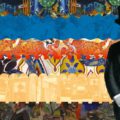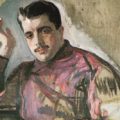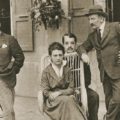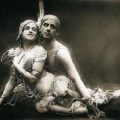“I am a painter without paintings, an author without complete works, a musician without a piece of music. If once the museum of myself is founded, what can one see there? My old shoes, my broken glasses?” That’s what Sergei Diagilev once wrote about himself.
He did leave behind neither property, nor original works. But if the memories of Diagilev scattered around the world could appear as paintings, they would form enormous art gallery capable to impress the most sophisticated art connoisseurs. Disputes about Sergei Diagilev continue till the present day. Some people believe him to be a cynical businessman, others — a genius manager, but what is undeniable for all of them is that Diagilev managed to make Russian art the subject of serious and permanent interest in Europe.
The world of art
Sergei Diagilev was surrounded by creative, progressive, young people of Saint-Petersburg and was imbued with love for the art as a student. He tried himself as a painter and a composer, but never did he manage to impress his contemporaries. But in 1897 when he was 24, he singlehandedly prepared and organized The Exhibition of English and German Watercolor Painters, followed by The Exhibition of Contemporary Scandinavian Painters, and The Exhibition of Russian and Finnish Painters in 1898, making the public talk about him. Not only did the last exhibition fully reveal the organizational skills of the young man, but also marked the beginning of the new association of painters “Mir Iskusstva” (The World of Art). The first issue of eponymous magazine, set to become one of the most influential titles in the Russian Empire, was published later this year edited by Diagilev. In 1905 in Tauride Palace in Saint Petersburg the exhibition of Russian portraits was opened showing four thousand works of art collected by Diagilev in just one year throughout all our vast country. The success of this exhibition had a serious impact on Sergei Diagilev — he believed that the time came to win European audience.
Russian seasons
Just a year later as a part of the “Autumn Seasons” in Paris the twelve halls in Grand Palais were dedicated to the Two Centuries of Russian Painting and Sculpture exposition, that in fact set the stage for the world-famous “Russian Seasons”. In 1907 the music of Russian composers was played in Grand Opéra, next year the opera Boris Godunov was performed with tremendous success among discerning public. In 1909 virtually the entire Paris was taped with posters with the picture of Anna Pavlova. Mixed program of opera and ballet was presented to connoisseurs of Russian art in Châtelet theatre restored upon the request of Diagilev. This season appeared to be a real cultural invasion and shaped the future of Russian Seasons for years to come. Starting from 1910 Sergei Diagilev has been engaging not only Russian but also foreign painters and composers and by 1913 he has formed permanent ballet company known as the Russian Ballet of Diagilev. Russian Seasons lasted until the death of their founder in 1929.
The Diagilev phenomenon
The string of cultural events sparingly put on paper cannot reflect even to the smallest extent the incredible amount of work that Sergei Diagilev and his associates did preparing exhibitions and the “Seasons”. Diagilev had a brilliant mind, he could obtain patrons and philanthropists, he appealed to the highest level of power, he could negotiate and persuade using “all the intrigue of the world”. He had a great artistic sense, and he could gather the best of the best, accomplished professionals, and gifted youth on one stage. Sergei Diagilev had no fear looking into the future, as he “performed for grandsons” which had paid off, as a number of his then-novel ideas are now classic. “We have to go headlong. We have to astound and not be fear it, act all at once, fully reveal ourselves with all the qualities and drawbacks of our nationality”.
Darya Serzhenko








